Scouting Tips: The "Secrets to Success!"
by Mark Richman
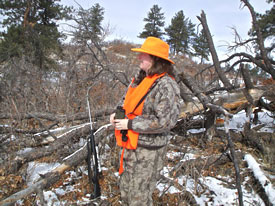 We all have to decide where to hunt somehow. This decision dictated by a few factors:
We all have to decide where to hunt somehow. This decision dictated by a few factors:
Since most people live near a population center of some sort, and are far from the areas they intend to hunt, some form of scouting or research must be conducted to find a specific place to hunt.
The purpose of scouting is for the out-of-area hunter to gain local knowledge to increase his or her odds of finding and harvesting elk.
Let's go through a couple of scenarios to determine how one might come to a conclusion about where to hunt. Each person will have different priorities based on where they are in their hunting career: inexperienced hunters typically just want to harvest a legal animal, then there are trophy hunters, and then the hunter who is just looking for an outdoor adventure or enjoyable experience. While scouting efforts are generally focused on finding game, don’t overlook finding a campsite and coming up with new tactics based on the terrain or man-made features in the area.
The Novice
The novice’s first task is to select a unit and season. Reference Lesson 2 - Planning a Successful Elk Hunt for information on this subject; we won’t get into that at this time.
Say you’ve settled on a unit to hunt during a rifle season. Now what? As with all scouting for any animal, you need to focus on the habitat needs of elk in order to find them. They need food, water, and cover. Whichever is in the shortest supply in the area is your primary focus. Elk are not evenly distributed throughout a mountain range; they are in large pockets with some small scattered herds. You're looking to maximize your chance of harvesting, and are therefore attempting to find the larger herds of elk. So keeping in mind that we need to feed, water, and conceal large herd animals, it’s time for a little remote scouting so we can better focus our efforts when we finally set foot on our hunting grounds.
Map it Out
Start with paper maps. Elk receive a lot of hunting pressure, and it doesn’t take much to force them to move to less pressured grounds. Follow these steps to eliminate high-traffic areas:
Take a fat highlighter and outline each maintained road, looking for large gaps in the highlighted areas. The highest pressured areas will be maintained roads that connect to other maintained roads.
A slimmer highlighter is also useful for the unmaintained and 4WD roads. Hunters will use them, but the more difficult the road, the less traffic you'll have. Unmaintained roads that connect two maintained roads receive more pressure than those that dead end.
You'll also want to pay attention to the ATV rules for your area and look for locked gates blocking access to old logging roads.
Lastly, find any marked or developed campground, and use your highlighter to mark off a two-mile radius from that campground. So, without even looking at the aerial photos or topography, we now have a just a few major areas to focus our search for a great hunting spot.
 Take a closer look at these roadless areas. Whether it is federally designated wilderness, or just an expanse of wild country, in a pressured area it is generally recommended that you hunt at least 1 mile from the road. Two miles is much better in the heavily hunted units if you are looking for unpressured animals.
Take a closer look at these roadless areas. Whether it is federally designated wilderness, or just an expanse of wild country, in a pressured area it is generally recommended that you hunt at least 1 mile from the road. Two miles is much better in the heavily hunted units if you are looking for unpressured animals.
Google Earth is a beautiful tool, so learn to use it in conjunction with your maps. It has color photos laid on top of a 3-D image of the earth. Once you learn to “ground truth” what you think you are looking at in Google Earth, you can get a very accurate feel for what the hunting area looks like.
Next, look at the topography and aerial photos. It takes a lot of forage to feed an elk herd, so areas near a large amount of grass or brush is important. We should be able to identify some open areas where the elk will be feeding at night, as there isn’t much forage in heavily timbered areas. Keep these facts in mind as you analyze the photos:
-
Elk can be anywhere between timberline (11,700 feet) and about 7,000 feet in Colorado during the 4 primary rifle seasons.
-
Generally, the warmer it is the longer the grass will stay palatable in the high country. As the frosts begin to hit the mountains in mid September, the grass will begin to desiccate (go dormant until spring), and only areas with cool season grasses and wetter areas will retain palatable grasses and sedges before the elk must switch to eating brush.
-
Elk are slaves to their stomachs and must eat at least every 8 hours or so. But, during hunting season, an elk's first priority is to save its hide, so it will need cover! Don't place much hope on finding elk out feeding in a high pressure unit; you need to find their escape routes and hideouts. Water is rarely lacking during the rifle seasons, so pinpointing elk usage solely by locating water is a little more difficult.
Now you've identified a couple of meadows using maps and aerial photos, preferably one with a small creek (not for the water, but for the greener, more palatable grasses). Many of these areas are right near roads or trails. Elk usually won't use these places during daylight, but if there aren't many options available, they will still use them. Since you're looking for a place to hunt on opening morning and you know there will be a lot of pressure on these roads near the meadows, you need to take advantage of that pressure by anticipating how the elk will react to it.
 Find Pressured Elk
Find Pressured Elk
Try to find an open saddle in the timber along a ridge as close to one of these meadows as possible. Try to stay within a mile or so. Saddles are just one of many types of bottlenecks that naturally funnel pressured elk. Drainages leading into and out of major canyons and junctions of several drainages (usually there is good water at these points also) are other great places to focus pressured elk.
So, out of all of the meadows you should be able to find a nearby saddle (or drainage junction) that:
Is at least a mile from a road
Has a feeding area between the saddle and the road
Is below timberline
Has some sort of opening for shooting lanes and dark coniferous timber nearby that elk may be heading to in order to hide
Get Out and Scout!
Once you’ve identified 3 or 4 good saddles or drainage junctions, it’s time to lace up the boots and spend a weekend or two out scouting. In August, it is unlikely that the main elk herds will be low enough to be using the meadows we’ve targeted. However, some units do not have true alpine country for elk to summer in, so it just depends on the unit.
Don't be discouraged if you don't see a lot of fresh sign. Instead, look for old sign that indicates elk may have used these meadows. Look at the encroaching brush along the edge of the meadow and ask yourself the following questions.
Do the ends of the twigs show old browsing pressure?
Are the encroaching aspens or pines partially dead for some reason (from browsing pressure and elk rubs, hopefully not bark beetles)?
What about the old brown grass from last year or earlier this year? Are the ends of it clipped off like a lawn mower?
Elk and deer browsing signs on brush and aspens or other small trees often have a "flag" due to their not having upper incisors.
Are there any small shrubs that look “stressed”, meaning many dead twigs protruding beyond the few live twigs that still have leaves on them? Or is the shrub no longer round?
Are there any old trails leading up to your saddle?
What about the old sign around your saddle or drainage junction?
Your hunting area should have at least some of these signs to let you know you're on the right track.
If the vegetation appears “hedged”, where the bottom of the junipers, aspens, scrub oaks, and similar trees and shrubs are all the same height, you are likely looking at winter range. That’s fine if you are hunting during the late seasons, but elk rarely present in such concentrations to create hedged environments during the normal rifle seasons. Otherwise, you need to be scouting higher elevations if you aren’t planning a late season hunt. If you are finding shed antlers while scouting, you may also be looking too low.
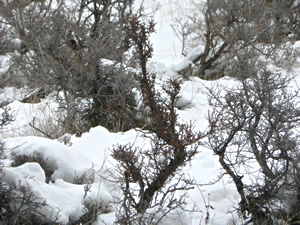 You likely won’t be able to spot and stalk (sitting on a high vantage point and using binoculars to find the elk then developing a stalk) elk in heavily pressured areas, but from a good vantage on an open saddle you may be able to pinpoint where elk are heading to escape from other hunters.
You likely won’t be able to spot and stalk (sitting on a high vantage point and using binoculars to find the elk then developing a stalk) elk in heavily pressured areas, but from a good vantage on an open saddle you may be able to pinpoint where elk are heading to escape from other hunters.
Timber
Don’t be afraid to stalk the timber, as elk spend more time in there than the open. If your escape route doesn’t produce for you, you’re going to have to have to go into the timber and pursue the elk. Coordinating a timber hunt with a partner is often more productive, especially if it’s possible to attack the patch from more than one side, pushing elk towards each other. The main types of timber you'll want to look for are:
If trying to pick a patch of timber to still-hunt (sitting in a blind or from a static location and waiting on the elk to come to you), the first places you need to investigate will be the flat timbered benches. These are often bedding areas and should show signs of elk usage during your scouting trips. Here, you won’t be looking for signs of browsing, just old tracks and feces. Old rubs are great too. If the area smells like fresh urine, or like cattle are in there, that’s another great sign. Many of these benches also have small ponds that are not marked on any map, but are visible from aerial photos. Focus your efforts near these spots.
Another type of productive timber for still-hunting is burned or thinned timber. Both types of timber can be great for cover and feed. Elk tend to feel very comfortable in burns, especially if the trees haven’t fallen yet. They feel concealed, yet are readily apparent to hunters, and the lush new growth offers great forage so they have no need to expose themselves in larger meadows. Along the same lines are areas of thinning operations. These areas have additional light hitting the forest floor, initiating grass and brush growth, but live trees are still in great abundance, offering good cover to the elk. These areas tend to have good shooting lanes and visibility through the timber for the hunter.
To find burns, you’ll need to use your aerial photos, but old logging operations are sometimes difficult to pick out. Instead, look for short spur roads coming off a main road. Many of those small roads will be gated off, blocked with boulders, or the entrance to them will be bulldozed. When scouting,
give extra bonus points to the roads that cannot be driven on. Aerial photos may not give you an adequate feel for the age of a burn and the amount of standing or down timber, so you need to scout it and decide whether it offers good feed and concealment to elk. Keep looking for sign. Old droppings are good, so are heavily browsed or stressed shrubs, and since the grass is often too long to reveal good trails, look for places where elk hooves have worn down or chipped away downed logs when they cross them.
If you’ve exhausted the escape routes, the obvious hide-outs, and scouted the timber, yet still can’t find elk sign, it’s time to either choose a new area or head down into the steep canyons and focus on the heavily timbered north and east facing drainages.
The Trophy Hunter
Pressured units can be tolerated by the trophy hunter, as long as there aren’t too many roads and access is limited in some areas. Designated wilderness isn’t a necessity, but it helps separate the “wheat from the chaff” in a real hurry. It’s difficult, however, to access many wilderness areas in the later seasons. You need to have a plan in mind when choosing which season to hunt the unit. Let’s assume we are hunting 1st rifle season . . .
Occasionally, elk are above timberline during 1st season, but it’s rare.
Finding large pockets of unpressured land is your best option. You don’t want pressure to ever reach the elk you're hunting, but it wouldn’t hurt if pressure would send additional elk your way! But first, you need to have a “measuring stick” so you know what kind of bull is possible in this area. It’s time for you to get up into the high country and glass elk on their summering grounds in July through mid-August.
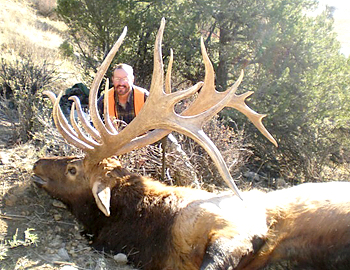 Location During Rut
Location During Rut
In classic, high mountain elk country, once the bachelor herds are found and trophy potential is determined, it’s a matter of figuring out where they might be during hunting season. From archery season through 1st rifle, they will likely be within the same drainage or neighboring drainage where you found them, just at lower elevation. The bulls will either be nursing their wounds or still in the rut, so where they are in this stage will dictate how to focus on potential areas to hunt them.
If they are still in the rut, they will be with the cows—meaning there are a lot of mouths to feed. Only the larger meadows will offer sufficient forage, so you must focus on the lower reaches of the drainage where several creeks begin to form the primary river or creek in the area. This will usually be the largest meadow in the area and the focus of most of the cows and the dominant herd bull. These meadows are best found several miles into a wilderness area. Large, south-facing slopes on high mountains can also hold the herds, but only with a good, nearby source of water.
In canyon country, pinpointing where a herd bull will be during the rut is more difficult. Water can be scarce here. So, search for good meadows within a mile of water, but isolated from the roads by over a mile. Canyon country elk herds, typically, are smaller and more evenly dispersed near the major water sources.
After Bugling
If the elk have quit bugling, you need to instead focus on smaller secondary meadows where the bulls will be trying to recover as much weight as possible to survive the winter. The very best places are the rare north and east facing meadows when it is warm out. These are often very small meadows, less than 200 yards wide, surrounded by heavy timber and good water. Level benches for bedding areas are not important for finding solitary bull bedding areas. The only thing in the world these bulls want is to be left alone so they can eat and rest. Your focus here needs to be over 2 miles from the nearest major road and over a mile from any secondary road. These small pockets don’t have to be north or east facing, but they do need to have good forage. During a warm year, the bulls may go back up to higher country if there is still good feed available.
Lone bulls are also much more likely than cow/calf groups to use steep hillsides. Below most steep mountains is a slide area, with strips of timber between the slides, springs, small ponds and creeks at the base, and open grassy hillsides in places where the slide is sufficiently old. These little pockets provide all the food, water and cover a lone bull will need for the month or so before winter really sets in and he is forced to descend to lower elevations.
Because their potential meadow locations are so varied, spot and stalk hunting is much more critical, especially if you have trophy standards.
Your scouting efforts should be focused on vantage points overlooking as many of these basins, meadows, and hillsides as possible, rather than trying to pinpoint a single small meadow. From one vantage point, many old slide areas can usually be seen, as well as the small pockets in the timber below. Road access to your vantage point is fine only if the points you are glassing are a long way off. If there is a tempting terrain feature to hunt immediately below your vantage point, and no barrier like a ridge or creek for a hunter to cross to reach that area you are glassing, you’ll need to find a different vantage. There must be very little disturbance reaching the area you will be glassing during hunting season.
The "Quality Experience" Hunter
Are you just looking to see wildlife and feel like you have some ground to yourself? Trophy quality may not matter to you, and you'll be combining tactics of both the trophy hunter and the meat hunter. You're looking to enjoy the experience and not necessarily an armed death-march to the farthest peak!
If you’ve settled on your unit, it’s time to decide how you want to hunt it. Some people like to find good roads to drive and glass the distant hillsides; others prefer a solitary still-hunt into the dark timber, while still others prefer to hike a nice vantage point to see what Mother Nature brings them. This hunter will also be conscious of the season to hunt.
Timing
In some places, first rifle season has the least pressure, in other areas it’s the 4th season. Even 3rd season in some over-the-counter units can have fairly light pressure, but 2nd season is almost never the best choice. If you're an archer, you wouldn’t bother going out during the first several weeks of the season, and would rather pick your time to coincide with the peak of the rut.
Here in Colorado, the third and fourth weeks of September are as good as it gets. Most of the bow hunters and muzzleloader hunters have already packed it in for the year. Assuming you're a 3rd season rifle hunter, you can generally count on roads still being accessible and snow in the high country pushing elk a little further down the mountain. You're most likely more focused on the “honey holes” outside of the wilderness, along migration corridors and pockets of public land near private lands.
 Location
Location
Depending on how you hunt, or want to hunt, consider hunting the longest ridges extending from the high peaks. Many of these are easily accessible from the roads and often provide a downhill hike (at first). The longest finger-ridges usually have several saddles for migrating game or those seeking refuge from other hunters. Those same ridges usually have one or two good places to glass the surrounding ridges or meadows below. The strategy here is to just keep walking farther than most other hunters will and get an earlier start!
The best places during the later seasons will have vantage points or will be above south- and west-facing brushy slopes. You can’t count on the grasses being palatable during the late seasons, so be mindful of secondary food sources like scrub oaks, bitterbrush, sagebrush, serviceberry, and mountain mahogany.
Water is less important during the later season hunts, but will still be utilized. Standing water will likely be frozen over, even if there is no snow. Summer scouting should focus on these brushy food sources that can be seen from a safe distance without disturbing the elk during hunting season.
Utilize the tips on finding browsed and grazed plants, described earlier, when examining these hillsides during the summer. Buck deer rubs are useful signs in these areas, even if you are elk hunting, because deer are primarily browsers (as opposed to grazers), and the presence of deer rubs indicates late October and early November preferential usage in those brushy areas. If hunting for elk, focus mainly on the grass availability on exposed south-facing hillsides above running creeks. These creeks will likely still be running during the late seasons, offering more reliable water sources.
In many parts of the west, irrigated private croplands are adjacent to public lands. These private lands rarely have sufficient cover to hold elk, but the forage is irresistible to them. Use your aerial photos to look for any croplands next to public lands. Elk and deer will likely be feeding at night and early in the morning, but at some point they will re-enter adjacent public lands. When scouting, look for sagging barbed wire, downed fencing, clear trails, hair snags on the wire, and other sign to indicate likely entry and exit points to these fields. Be certain you are on public land when attempting to hunt these locations.
Not all hunters have the stamina to hunt the backcountry, so finding isolated pockets that pressure will rarely touch that are near a road should be the focus if the above sounds like a forced march to you. For those who can exert themselves over short periods, but cannot sustain the effort, use your maps and aerial photos to find places close to, but not visible from, the roads.
Oftentimes, a road will pass just a quarter of a mile underneath a ridge, and many hunters will never bother to look at what’s on the other side. Sometimes, a difficult terrain feature such as a creek with steep banks separates the road from an unseen meadow. In most mountainous country, roads wind back and forth as they gain elevation. These gaps between the roads are also useful for short hunts, especially when coordinated with a partner or two who will park the vehicle at the bottom for you to hunt toward. Some maps do not show the road windings in sufficient detail and many aerial photos fail to show the roads underneath the timber, so scouting is crucial here. If there is ever more than a ¼ mile gap between the roads, consider it huntable.
Last Minute Scouting
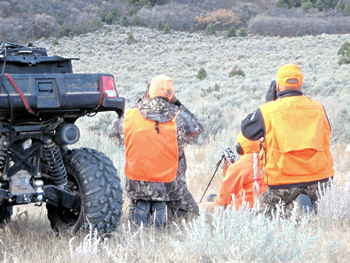 For those who can’t put "boots on the ground" in elk country during the summertime, it is strongly recommended you give yourself at least one full day of scouting prior to the season opening. You’ve presumably narrowed down your hunting area by various remote scouting methods, whether by paper map, aerial photos, interviews, etc., but let’s say you are trying to narrow down your hunting area to near two drainages where you’ll be camping.
For those who can’t put "boots on the ground" in elk country during the summertime, it is strongly recommended you give yourself at least one full day of scouting prior to the season opening. You’ve presumably narrowed down your hunting area by various remote scouting methods, whether by paper map, aerial photos, interviews, etc., but let’s say you are trying to narrow down your hunting area to near two drainages where you’ll be camping.
Your first order of business is not to spook game out of the country; you must minimize your intrusions at this time. You’ll have to walk with your eyes more than your legs. Dawn and dusk should be spent glassing or driving the roads and glassing.
When driving snow covered or dirt roads, keep a careful eye out for any trails indicating elk crossing the road. Note whether elk appear to be crossing back and forth on this road, or whether it was a one-way trip. If the snow is less than a day old, consider following those tracks. During the late morning and early afternoon, skirt any timbered potential bedding area as well as you can and do not “skyline” yourself when coming over ridges. Don’t be too concerned if there are elk carcasses in your new spot—consider it validation.
Sign
Unlike summer scouting, the freshest sign wins when you’re only a day or two from the start of the season. When reading fresh sign, a little additional knowledge will tell you what the elk are eating and the likely sex of the animal you found:
When elk are feeding on green grasses, their feces tend to be clumped and extremely soft.
When elk have switched their feed to brush, their droppings become much harder and individual pellets tend not to clump together.
If you think they are feeding on grasses, the elk are probably feeding in a wet meadow.
If you think they are feeding on brush, it is likely on a south- or west-facing hillside.
Some people have trouble telling deer or moose sign from elk sign. Cow elk and small bulls tend to have tracks about 3 inches long, more mature bull elk have tracks around 3.5 inches long. A standard, factory loaded .30-06 cartridge (and most standard and belted magnums) is 3.3 inches long; .308s and other short-action cartridges (including the short magnums) are 2.8 inches long. If the track is longer than a short-action cartridge, but shorter than a standard, it is likely that of a cow elk. Anything significantly longer than a .30-06 is probably a bull—except when you are in moose country! Moose tracks, however, are much larger than elk tracks, often closer to 5 inches long. Their droppings are almost always slightly red, grainy, and elongated due to the willows that they prefer to eat.
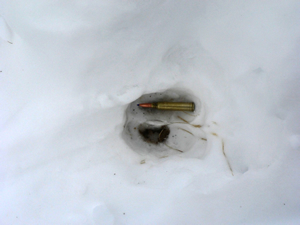 In many ways, hunters need to be amateur biologists in order to properly read the signs the elk are leaving. If you are unsure of what you are looking at and how to interpret the signs, take a picture so you can show it to someone more experienced than yourself for interpretation. Be prepared to ask specific questions of everyone you encounter while out scouting, but if you haven’t done your homework you won’t know when to disregard and when to accept information as gospel.
In many ways, hunters need to be amateur biologists in order to properly read the signs the elk are leaving. If you are unsure of what you are looking at and how to interpret the signs, take a picture so you can show it to someone more experienced than yourself for interpretation. Be prepared to ask specific questions of everyone you encounter while out scouting, but if you haven’t done your homework you won’t know when to disregard and when to accept information as gospel.
You will be at a severe disadvantage if you haven’t set foot in your hunting area before the season starts. The only way to move further along the learning curve is to spend more time in the elk woods. The local, area-specific knowledge you gain from doing so is worth infinitely more than reading books and articles. Understanding what the sign is telling you and what do with that sign is a crucial step in becoming a good elk hunter.
Our hunting seasons are short, so you will not get the necessary field time to become a knowledgeable elk hunter by spending only 5 days in the woods each year. Get out there, scout intelligently, learn your hunting grounds, become a more successful hunter!
Good luck!

